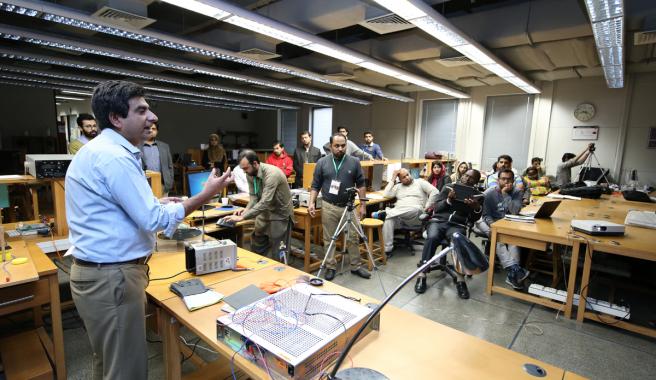
The Regional Lab Immersion Programme 2016 was quite an event – a week of intense lab work, coupled with jokes, team work, presentations, food, excursions and a tranquil sense of satisfaction that comes with learning new physics and teaching it to others! The fourth programme of this series concluded on December 22 with a heavy heart, burdened by the impending feeling of partition, and that it had all ended so soon.
The first day started with a hands-on activity led by Dr. Samya Zain from the Susquehenna University. She asked students to launch a projectile and a falling object so that they simultaneously hit each other at the ground while students were allowed only a single attempt. Imagine university teachers vying for success in a task as simple as ensuring a collision. Dr. Sabieh Anwar, faculty at the Physics department, then led students through a practical example illustrating data taking from a string of oscillators hung from a suspended wire and quivering inside the earth’s field. The role of uncertainties was highlighted, a graph was plotted and students were able to estimate the earth’s field.
Talking about the programme, Dr. Anwar said, “Frankly, I myself didn’t know what immersion meant until I organised the first such programme back in 2012. The idea was reinforced here. Immersion is when ‘physics has taken over’. In the sessions, we saw our participants being knocked down into practical work, forgetting their worries and joys and deriving pleasure or anxiety from nothing but experimental physics. This act of drowning, qualifies these seven days of concentrated activity is the physics immersion programme. Students, while working in pairs, could now measure band gaps of semiconductor material, observe the DC Josephson effect, measure lifetimes of muons, observe the conservation of energy in collisions, detect micro-degrees of rotations of polarization inside a magnetic field, find the wavelength of electron waves or estimate the latent heat of vaporization of liquid nitrogen. All of this happened between December 17 and 18.”
“Modern physics laboratory practice is distinctly different from twenty years ago. New tools and skills have risen. There are ‘arduinos, raspberry pi’s’ (fancy names of extremely powerful low-cost devices), data acquisition, 3D printers, cameras and smartphones. Capabilities unleashed by these tiny monsters can also frighten the novice, especially so for teachers in the developing world who are starved of appreciation, mired in bureaucratic procedures, and demotivated by financial apprehensions. The utter lack of instructional laboratories in some institutions also takes away any opportunity or exposure. That’s why we decided to provide students with a compressed practical session on data acquisition. Muhammad Adnan from National Instruments led this session. The simple task was to use the computer as an oscilloscope and a function generator,” said Dr. Anwar.
Umar Hasan’s presentation on video tracking was an instant hit. It turned out that the use of cameras and smart phones attracted everyone’s attention. From compressed springs to pendulums, locomotion of insects to colliding carrom pucks, video capturing followed by powerful processing and analysis tools, such as Physlab’s Phystrack, provides unprecedented joy in illuminating hidden facets of kinematics. Observing the trajectory of the erratic motion of microspheres suspended in a fluid or a marble rolling down the surface of a bowl was very interesting for the students. For the same reason, several students used video tools in the projects during the programme.
The practical work was interspersed by several presentations from the visiting participants and students who worked under Dr. Anwar’s supervision in various laboratory projects. It all kicked off by Dr. Hanan Sa’adeh’s motivating presentation connecting the pursuit of physics with the search for aesthetic quality that eventually renders the experimental physicist into an artist. LUMS physics students shared their work on quantum erasure, tracking cosmic ray muons, chaos and nonlinear dynamics of pendulums and circuits, superconducting quantum interference devices. Dr. Wilson Ombati briefed the students about metrology and how to measure weights, signalling how the SI paradigm of units is about to undergo a fundamental overhaul. Sarah Maher convinced the audience that remote virtual experiments have an important role to play in physics teaching while Islam Majed took students through his attempts to revive Ibn-al-Haitham’s camera obscura at the University of Jordan.
Umair Asim‘s invited talk on astronomy in the light polluted Lahore took the programme participants into a voyage through the heavens. He showed glimpses of his amazing observations on variable stars, galactic dust and nebulas, solar flares and prominences and apprised the students of the inevitable importance of long, patient and painstaking observations made on a meticulously constructed, vibration-free and ultra-precise high resolution astronomical imaging system. These conflicting requirements are a universal feature of all serious projects in experimental physics.
During the programme, students were asked to design and create something new as Dr. Anwar felt that ‘in this part of the world, physics has traditionally been condemned to a mere exercise in analysis or more recently, in problem solving.’ To encourage creation and invention, in the final stages of the programme, students were asked to muster their entrepreneurial spirit and group into small teams to design new experiments. They tried to follow dripping water from a faucet, the dynamics of discharge from a cylinder, the phase space trajectory of motion of spheres on curved surfaces, verifying Boyle’s law, measuring the speed of light and analysing bouncing balls. Video tracking remained a popular feature. The closing ceremony was an exciting event for the participants as Dr. Umar Saif from the Punjab Information Technology Board and Syed Babar Ali, founder and Pro Chancellor of LUMS inspired students with their graceful presence.
For more information and pictures, please click here.








